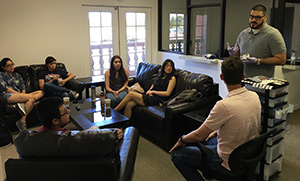The University of Arizona Health Sciences Center for Sleep & Circadian Sciences (UAHS CSCS) wins $5 Million Construction grant from the NIH Office of Director (NIH-1C06OD028307)
The 2017 Nobel Prize in Physiology or Medicine was awarded for the discovery of the molecular mechanisms controlling our circadian rhythms but the study of circadian rhythms and sleep in humans requires a facility that has exquisitely controlled environment for intensity, time duration, and color of light, temperature, and noise levels. Improved understanding of the molecular mechanisms of circadian rhythms and sleep in animal models has catapulted biomedical research in this area which is at a very exciting juncture in time, but translation to the human condition requires institutional infrastructure that can facilitate a multi-disciplinary team to conduct cutting-edge clinical-translational research. The overarching objective of our proposal is to develop a modern facility with a highly controlled environment that is proximal to advanced imaging facilities and clinical areas to enhance the conduct of cutting-edge human sleep and circadian rhythms research to advance our understanding of disease processes involving multiple biological systems that would serve a broad research community at the University of Arizona. Such broad and cross-cutting impact is because sleep and circadian rhythms can influence the gamut of health from the cellular level (e.g., clock genes influencing inflammation and cancer risk); organ-systems (e.g., cognition, heart disease, and stroke risk); behavioral health and severe mental illnesses; and at a macroscopic level affect public health and safety (e.g., traffic accidents secondary to sleepiness). There is a long history of sleep research at the University of Arizona spanning over 4 decades with pioneering contributions to the connection between sleep and cardiovascular disease (as a vanguard site for the NIH-funded Sleep Heart Health Study), neurocognition, and behavioral intervention. Since this time, sleep research at the UA has grown exponentially with more than eighteen investigators from five colleges and nine departments across the University of Arizona conducting sleep and circadian rhythms research. The existing sleep and circadian rhythms research facility is a leased property that is not amenable to renovation for the sophisticated control and monitoring of the environment (lighting, noise, temperature, and respired gases) for extended periods of time. Moreover, this center is far removed from clinical research areas and imaging facilities and researchers are unable to perform brain imaging; remotely administer therapies that includes manipulation of respired gases and intravenous therapies; or collect blood samples without perturbing a research participant's sleep. The new facility will be in close proximity to imaging facilities, clinical research areas, and other research laboratories within UA campus and will also allow manipulation of the respired gases and administration of intravenous medications and blood sampling from an adjacent anteroom. The proposed facility is vitally needed as a shared resource to facilitate ongoing and future planned NIH-funded sleep and circadian rhythms research and advancements in such clinical and translational research that brings treatments and cures to patients and the public.
The University of Arizona Health Sciences Center for Sleep & Circadian Sciences (UAHS CSCS) was established in May 2016 and is one of many centers of research excellence at the University of Arizona.
 The center brings together researchers from three colleges within the health sciences (Medicine, Nursing, and Public Health) belonging to various departments (Medicine, Psychiatry, and Physiology). Collaborators from the Colleges of Education, Psychology and Agriculture (Nutritional Sciences) also contribute to the mission of the center. Besides the four areas of emphasis set by the Senior Vice President of UAHS office -- Neuroscience, population health and outcomes, precision science, and health disparities – the center focuses across the translational spectrum from knowledge generation to dissemination and implementation science.
The center brings together researchers from three colleges within the health sciences (Medicine, Nursing, and Public Health) belonging to various departments (Medicine, Psychiatry, and Physiology). Collaborators from the Colleges of Education, Psychology and Agriculture (Nutritional Sciences) also contribute to the mission of the center. Besides the four areas of emphasis set by the Senior Vice President of UAHS office -- Neuroscience, population health and outcomes, precision science, and health disparities – the center focuses across the translational spectrum from knowledge generation to dissemination and implementation science.
The center consists of a free standing sleep and circadian sciences research center with a total of 2,700 sq. ft., 4-patient bedrooms that can be used as interview or examination rooms during the day, and sleep studies (polysomnography) at night. State of the art sleep diagnostic hardware and software, specialized equipment for performing sophisticated measurements and novel therapies, as well as a shared 1,000 sq. ft. conference room with audio-visual equipment for videoconferencing enable the conduct of high quality research. The bedrooms are furnished with Sleep Number beds that adapt to patient’s comfort needs and one of the larger bedrooms is furnished with an additional bed to enable the conduct of pediatric polysomnography that would allow the parent to sleep in the same bedroom if research study protocol allows for the same.
| 1C06OD028307-01 |
